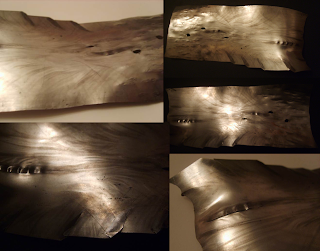Next in applied arts was ceramics. we started by making small pots from red clay, my favourite method was the coil pot, because it was very easy to build up in the shape I wanted, and then could be smoothed out at the end, or left quite bumpy to make an interesting surface texture. We made other pots from grainy clay, using a dragging technique instead of rolling to lengthen the clay, so the texture stayed in the clay. I just used my hands to shape the clay into a conical pot.
As well as making pots, we also rolled out slabs. Once my slab was flat and smooth, I painted it with white slip. I had to be very careful when I was painting onto the slab to only paint one way, so as not to mix the red clay into the slip. Once the slip was dry, I used a needle to carve a picture into the clay, so the red showed through where I had drawn.
 I chose to draw birds, and then added more detail in the background to make a whole scene.
I chose to draw birds, and then added more detail in the background to make a whole scene. My favourite part of ceramics was having a go on the potters wheel. I found it easy to control the speed of the wheel, but it was difficult to keep my hands in the same place, and not move them with the clay. It was also difficult to keep the walls of the pot the same thickness all the way up, and not make thinner or thicker parts that might make the pot overbalance or deform as the wheel spins. Overall, I was very happy with my first attempt at throwing a pot.
My favourite part of ceramics was having a go on the potters wheel. I found it easy to control the speed of the wheel, but it was difficult to keep my hands in the same place, and not move them with the clay. It was also difficult to keep the walls of the pot the same thickness all the way up, and not make thinner or thicker parts that might make the pot overbalance or deform as the wheel spins. Overall, I was very happy with my first attempt at throwing a pot.






































